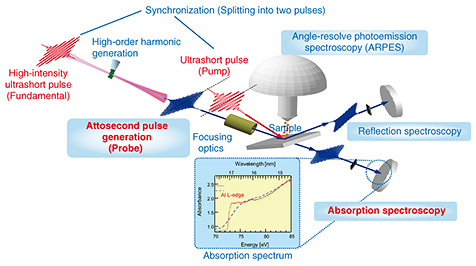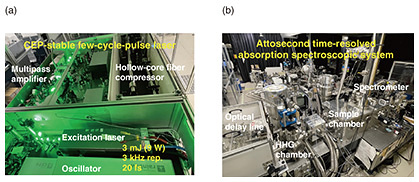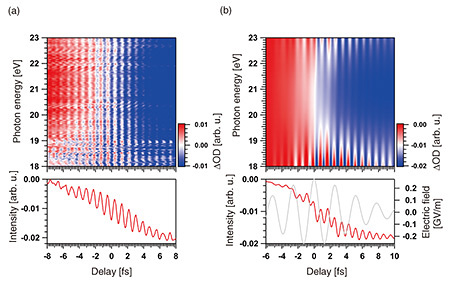 |
|||||||||||||||||||||||||||||||||
|
|
|||||||||||||||||||||||||||||||||
|
Feature Articles: The Frontiers of Ultrafast Optical Physics Research Vol. 23, No. 5, pp. 29–35, May 2025. https://doi.org/10.53829/ntr202505fa4 Attosecond Time-resolved Spectroscopy for Light-electron Interaction in Solid-state MaterialsAbstractPump-and-probe attosecond time-resolved spectroscopy based on an isolated attosecond pulse source is the fastest measurement technique available to humans, which enables us to capture unprecedented ultrafast phenomena with a temporal resolution on the attosecond timescale. NTT Basic Research Laboratories has developed the most basic attosecond spectroscopic technique consisting of an isolated attosecond pulse source and time-resolved near-infrared-pump attosecond-probe absorption spectroscopy. In this article, an application of this technique to real-time measurement of electronic responses induced by lightwave fields in wide-gap semiconductors is presented. Keywords: attosecond pulse, attosecond time-resolved spectroscopy, lightwave-electron interaction 1. Towards attosecond dynamic control of electronic system by lightwave-electron interactionsThe generation and measurement of attosecond pulses in the early 21st century is a great achievement of mankind’s never-ending quest to see and understand faster things. Electrons are the physical systems that play a fundamental role in all technologies that support modern society, including information processing, chemical reactions, energy harvesting, and biological reactions. Since the natural timescale of their motion is in the attosecond range, it has been a representative example of ultrafast phenomena that have been inaccessible to humans because of their extremely high speed. Among the wide variety of ultrafast phenomena of electrons, we at NTT Basic Research Laboratories (NTT BRL) are especially interested in attosecond-timescale dynamics induced by the interaction between light and electrons [1]. The reason for this is that we already have an order of magnitude faster control knob for electrons compared with current techniques based on the recent technological advances in the control of light. Attosecond spectroscopic techniques are powerful tools to visualize the ultrafast dynamics of the electron system’s response to such a lightwave field. The techniques are currently categorized into two main types. The first type is high-harmonic spectroscopy, which measures the spectrum of the high-harmonics from the material to be investigated and derives the underlying attosecond electron dynamics in the material. As shown in the three-step model introduced in “Prospects for the Frontiers of Ultrafast Optical Physics Research: Engineering Petahertz Waves” [2] in this issue, the generation of high-harmonics originates from the motion of electrons induced during one cycle of an intense ultrashort laser pulse electric field. The generation process in the material corresponds to the attosecond electron dynamics driven by a lightwave electric field. The attosecond electron dynamics can be estimated by combining experimental results with theory and simulation. The second type is pump-probe attosecond time-resolved spectroscopy. The basic form of this technique is to use intense ultrashort pulse as the pump beam and an isolated attosecond pulse as the probe beam, which corresponds to the concept of the attosecond movie based on snapshot measurement with attosecond pulses described in the article [2]. Conversely, it is also possible to use an isolated attosecond pulse as the pump beam and ultrashort pulse as the probe beam. Moreover, attosecond-pump attosecond-probe spectroscopy, which uses high-intensity attosecond pulses as both pump and probe beams, is also attracting attention as the next target. However, it is generally recognized as an extremely difficult technique due to the remarkably low conversion efficiency of current attosecond pulse generation technology. Comparing the advantages and disadvantages of the two techniques, high-harmonic spectroscopy is technically simpler than pump-probe attosecond time-resolved spectroscopy. With high-harmonic spectroscopy, we only measure the spectrum of the generated attosecond pulse from the sample to be measured. On the other hand, pump-probe attosecond time-resolved spectroscopy uses the generated attosecond pulse as a probe beam to measure the response of attosecond pulses to the electron system in the sample. Although this spectroscopy requires a more complicated experimental setup, it is possible to directly obtain dynamical information of the electronic system in the time domain. 2. Ultrashort-pulse-pump attosecond-pulse-probe time-resolved spectroscopyThis section describes the most typical example of attosecond time-resolved spectroscopy, which is a high-intensity ultrashort-pulse-pump attosecond-pulse-probe time-resolved spectroscopy (Fig. 1). Pump-probe attosecond time-resolved spectroscopy was initially applied to electronic dynamics in gaseous atomic or molecular systems. In gaseous atomic systems, it was applied to measure the dynamics of photoionization processes of atoms, lifetime of core-excited states, coherent control of photoexcited states, etc. In simple gas-phase molecular systems, it was applied to measure the photodissociation processes of molecules and the charge transfer within molecules. Thus, its effectiveness as a measurement technique for the dynamics of light-matter interactions has been clearly demonstrated [3]. Its application to solid-state electronic systems began in the 2010s, and ultrashort-pulse-pump isolated-attosecond-pulse-probe absorption spectroscopy has been used as a typical technique. As shown in Fig. 1, the measurement system consists of an isolated attosecond pulse source used as a probe beam, intense ultrashort pump pulse synchronized with the probe beam, and absorption spectroscopy system to acquire the transmission spectrum of the probe beam. To achieve timing synchronization of the pump and probe beams, the output pulse from an intense ultrashort pulse laser is usually split using a beam splitter for generating the pump and probe beams. The relative timing of the pump and probe beams reaching the sample can be controlled with attosecond time precision by means of an optical delay line. To achieve a temporal precision of 10 as, for example, the two optical paths that comprise the optical delay line must be stabilized with an accuracy of several nanometers, and the optical path length must be controlled according to the attosecond time interval. This requires a common optical path for the pump and probe beams to cancel the effects of fluctuations in optical path length or optical path length stabilization by a feedback loop. In addition, the typical wavelength of attosecond pulses is in the extreme ultraviolet region and cannot propagate through air. Therefore, the measurement system basically consists of a vacuum chamber.
We at NTT BRL constructed an experimental station for attosecond time-resolved spectroscopy, which is based on an intense Ti:sapphire femtosecond laser multipath amplifier with a center wavelength of 790 nm, pulse energy of 3 mJ, pulse width of 20 fs, and 3-kHz repetition rate (Fig. 2(a)). The laser system incorporates carrier-envelope-phase (CEP)*1 stabilization and can generate few-cycle (4 to 7 fs) pulses with a hollow-core fiber compressor. On the downstream side, several beamlines consist of vacuum chambers for attosecond pulse generation and attosecond time-resolved spectroscopy (Fig. 2(b)). At these beamlines, not only attosecond time-resolved absorption spectroscopy, which is the subject of this article, but also attosecond time-resolved reflection spectroscopy, attosecond time-resolved photoemission spectroscopy, and other new types of pump-probe attosecond time-resolved measurement techniques are being developed.
3. Generation of isolated attosecond pulses using quasi-monocycle pulsesThe most important technology that constitutes an attosecond time-resolved measurement system is the probe, an isolated attosecond pulse source. As described in the article [2], to obtain an isolated attosecond pulse, it is necessary to extract only a single burst of attosecond pulse from the attosecond pulse train, where an attosecond pulse is generated at every half-cycle period of the fundamental pulse. To achieve this, we combined an intense sub-two-cycle fundamental pulse source and the double optical gating technique*2 for generating a near-ideal isolated attosecond pulse [4]. Figure 3 shows the spectrum and temporal shape of the sub-two-cycle pulse used as the fundamental pulse and the generated attosecond pulse. A pulse with a duration of about 20 fs output from a 3-kHz repetition rate CEP stabilized Ti:sapphire laser was used to generate the sub-two-cycle pulse. The pulse is focused onto a hollow-core fiber with a length of 1 m and inner diameter of 400 μm, which is injected with Ne gas at a pressure of about 1 bar. The spectrum of the pulse is thus broadened by the self-phase modulation effect, followed by the pulse compression with ultra-broadband chirped mirror pairs. A 1.6-cycle pulse with a bandwidth of 139 nm, pulse width of 4.1 fs, and pulse energy of 1 mJ in the 800-nm band was successfully generated (Fig. 3(a)). Figure 3(b) shows a typical spectrum of the generated attosecond pulse. The spectrum is not a comb-like spectrum characteristic of attosecond pulse trains (the article [2], Fig. 3) but a continuum with a continuous distribution of spectra over a broad bandwidth. The peak of the spectrum is at about 140 eV, and the full width at half maximum of the continuum reaches about 70 eV. This bandwidth corresponds to a pulse width of 32 as, assuming a Fourier transform-limited pulse*3 (Fig. 3(b)). To confirm that the measured continuum spectrum is an isolated attosecond pulse, we measured the relative CEP dependence on the continuum spectrum (Fig. 3(c)). Since changing the CEP corresponds to changing the peak electric field of the fundamental pulse, the spectral distribution of the attosecond pulse changes periodically according to the CEP. The periodic dependence of the CEP of the spectrum and maintenance of the continuum nature of the spectrum over all CEPs confirms that the attosecond pulse is isolated. As shown in Fig. 3(c), the CEP dependence of the spectrum of our generated attosecond pulse has a periodicity of 2π, and the continuum nature of the spectrum is maintained over all CEPs, thus confirming isolated attosecond pulse generation. Note that the period of 2π is because the fundamental pulse loses its inversion symmetry and becomes an asymmetric electric field due to the effect of the two-color gate with the double optical gating technique. In this experiment, the periodicity of 12π was clearly confirmed over 2 hours, which also confirms that the CEP of the 1.6-cycle pulse for attosecond pulse generation is stable over a long period. This supports that an isolated attosecond pulse can be generated stably over a long period by setting an appropriate CEP.
4. Observation of petahertz electronic oscillations in wide-gap semiconductorsThe most basic form of attosecond spectroscopy for measuring lightwave-electron interactions is time-resolved absorption spectroscopy with an ultrashort-pulse-pump and isolated-attosecond-pulse-probe geometry. With this spectroscopy, a sample is irradiated with an ultrashort pulse to generate an excited electronic state in a material, and the amount of attosecond pulse absorption in the excited state is detected as a function of the time delay of the attosecond-probe to the ultrafast-pump pulses. A pioneering example is the 2ω periodic modulation of an attosecond pulse absorption observed in silica (SiO2) thin films irradiated with intense ultrashort pulsed light with a center frequency of ω [5]. This observation is interpreted as the Wannier-Stark localization*4 of the electronic band induced by the irradiation of a 1-V/Å-class two-cycle lightwave field on the insulator, and the occupied/unoccupied state of the Wannier-Stark localized level is reversibly changed in the 2ω period by the lightwave field. Such coherent manipulation of solid-state electronic systems by lightwave fields on the optical-cycle temporal scale is a promising function of petahertz (PHz)-class signal processing. The most fundamental light-matter coherent response induced in light-matter interactions, even without ultrahigh electric fields over 1 V/Å, is lightwave-induced oscillations of electronic polarization. The electronic polarization oscillation is an electronic response that is the most fundamental origin of various optical responses such as reflection, transmission, and absorption in light-matter interaction. Since the period of the oscillation is basically on the timescale of the period of the irradiated light, its time-domain measurement has been impossible unless done with attosecond time resolution. I introduce a time-domain measurement of the nonlinear electronic polarization response in gallium nitride (GaN) by using the NTT BRL’s attosecond time-resolved spectroscopic beamline [6]. In the experiment, an isolated attosecond pulse with a central energy of 21 eV and duration of about 660 as was used as a probe beam, and a near-infrared pulse with a duration of about 7 fs and peak intensity of 1 × 1010 W/cm2 was irradiated to a thin GaN crystal with a thickness less than 100 nm. Differential absorption spectra (the ratio of the absorption spectrum with and without pump irradiation) were then measured as a function of the delay time between the pump and probe beams (Fig. 4(a)). The temporal evolution of the differential absorption spectrum clearly shows a characteristic time-domain oscillatory structure over the entire absorption spectral bandwidth. Averaged over the energy direction, the periodicity of the oscillatory structure was found to be 860 as. This period corresponds to a frequency of 1.16 PHz, and we succeeded in measuring oscillations above 1 PHz in solid-state electron systems with a time-domain measurement. This period corresponds to one-third the period of the irradiated near-infrared pulse (2600 as), indicating that this oscillatory structure corresponds to the third-order nonlinear polarization oscillation in the time domain. Numerical simulations of the optical Bloch equation [1], in which the valence band, conduction band, and attosecond pulse absorption band of GaN are simplified as pseudo-levels, show good agreement with the experimental results (Fig. 4(b)). In the simulation, the decay time was assumed to well reproduce the experimental results, and its time constant was estimated to be 3.3 fs. This decay time is similar to the interband phase relaxation time of 3.5 fs for gallium arsenide (GaAs) at room temperature measured using the photon echo method*5. The approximate agreement between these two values suggests that the decay reflects the interband phase relaxation time in GaN at room temperature. This experiment indicates that the measurement of the lightwave-driven electronic motion is the first step toward the PHz control of solid-state electronic systems.
5. Attosecond spectroscopy: the 2nd generationThis article described the main components of attosecond time-resolved measurement technique developed by NTT BRL: isolated attosecond pulse generation and attosecond time-resolved absorption spectroscopy. As an example of actual application of this technology to solid-state electron systems, I introduced a real-time measurement experiment of PHz-frequency oscillations of lightwave-induced electronic polarization in a GaN semiconductor. With attosecond time-resolved absorption spectroscopy, accumulating signals over a long period (several tens of hours) is indispensable to improve the signal-to-noise ratio of the data. However, the detection sensitivity of the signal (the ratio of the modulation intensity to the unmodulated signal intensity) is limited to only 10−2 due to the poor signal-to-noise ratio. It is practically difficult to measure parameter dependence such as temperature dependence, pump intensity dependence, and sample carrier concentration dependence. As discussed in the article “Megahertz-repetition-rate 1.7-cycle Intense Pulse Sources for Future Bright Attosecond Spectroscopy” [7], we are planning to increase the average output power of the driver laser by a factor of 10 or more to achieve high brilliance in isolated attosecond pulse generation, thus significantly improving the signal-to-noise ratio. In addition to the absorption spectroscopy discussed in this article, we also plan to expand the technique to include various attosecond time-resolved spectroscopy techniques such as reflection spectroscopy [8], interferometry [9], and angle-resolved photoemission spectroscopy [10]. This will make it possible to measure experimental information that is complementary to each other. By combining these techniques from the experimental side with the first-principles-based real-time quantum simulations discussed in the article “Exploring Ultrafast Electron Dynamics and Extreme Nonlinear Optics Induced by Intense Optical Field” [11] in this issue, we expect to create a comprehensive physics of lightwave-electron interactions. The ultimate pursuit of such light-source, measurement, and simulation technologies will lead to a breakthrough in the control of attosecond-scale electron systems using PHz waves. The research topics described in this article are the result of joint research with Dr. Hiroki Mashiko (NTT Advanced Technology at present), Prof. Yasutaka Hanada and Tatsuya Ogawa of Hirosaki University, Prof. Ryo Suda and Tomohiko Yamaguchi of Tokyo University of Science, and Prof. Hideki Gotoh (Hiroshima University at present) and Prof. Hidetoshi Nakano (Toyo University at present). This work was also supported in part by JSPS (Japan Society for the Promotion of Science) Grants-in-Aid for Scientific Research (JP23310086, JP25706027, 16H05987, 16H02120). We would like to take this opportunity to express our deepest gratitude. References
|
|||||||||||||||||||||||||||||||||





